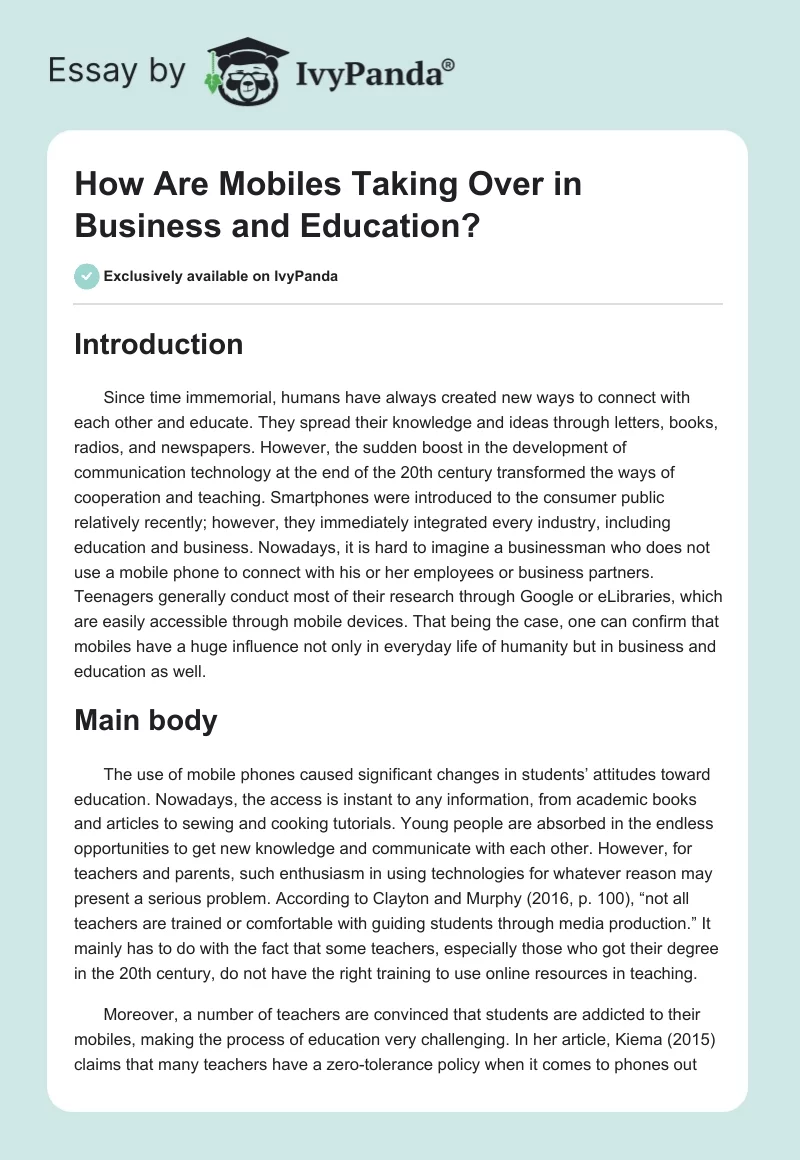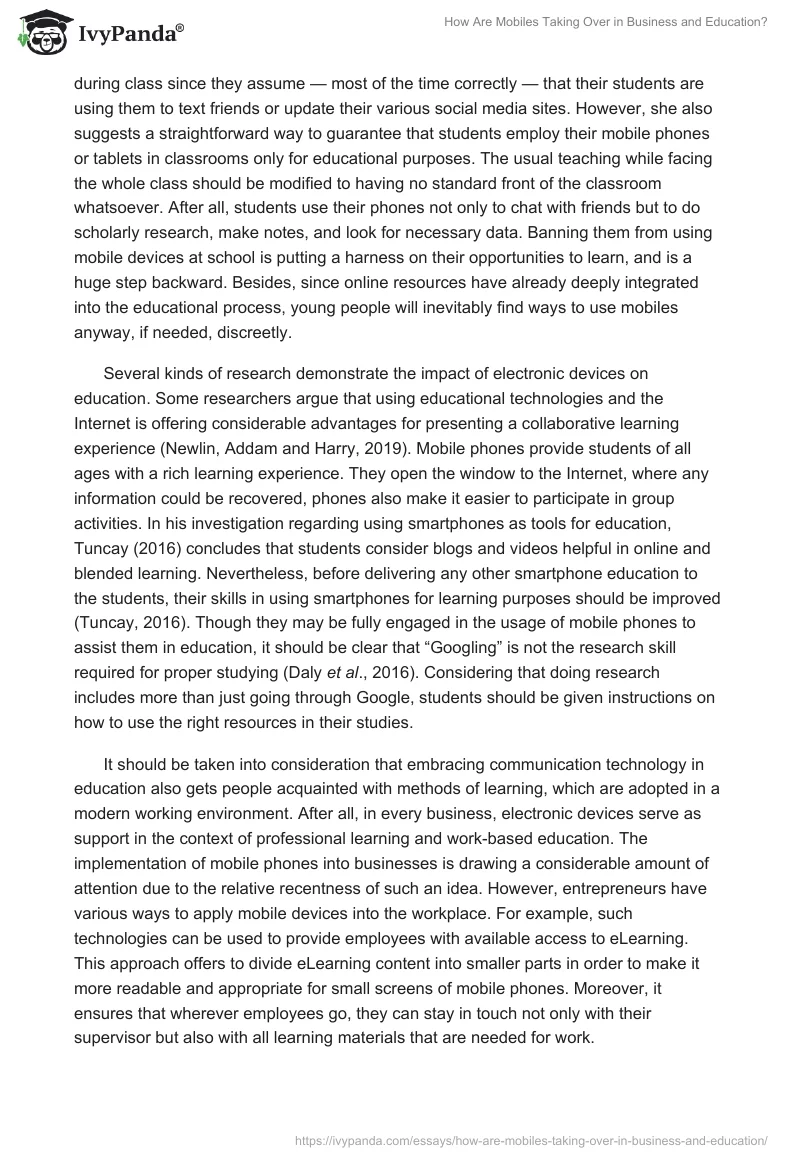Introduction
Since time immemorial, humans have always created new ways to connect with each other and educate. They spread their knowledge and ideas through letters, books, radios, and newspapers. However, the sudden boost in the development of communication technology at the end of the 20th century transformed the ways of cooperation and teaching.
Smartphones were introduced to the consumer public relatively recently; however, they immediately integrated every industry, including education and business. Nowadays, it is hard to imagine a businessman who does not use a mobile phone to connect with his or her employees or business partners.
Teenagers generally conduct most of their research through Google or eLibraries, which are easily accessible through mobile devices. That being the case, one can confirm that mobiles have a huge influence not only in everyday life of humanity but in business and education as well.
Main body
The use of mobile phones caused significant changes in students’ attitudes toward education. Nowadays, the access is instant to any information, from academic books and articles to sewing and cooking tutorials. Young people are absorbed in the endless opportunities to get new knowledge and communicate with each other. However, for teachers and parents, such enthusiasm in using technologies for whatever reason may present a serious problem.
According to Clayton and Murphy (2016, p. 100), “not all teachers are trained or comfortable with guiding students through media production.” It mainly has to do with the fact that some teachers, especially those who got their degree in the 20th century, do not have the right training to use online resources in teaching.
Moreover, a number of teachers are convinced that students are addicted to their mobiles, making the process of education very challenging. In her article, Kiema (2015) claims that many teachers have a zero-tolerance policy when it comes to phones out during class since they assume — most of the time correctly — that their students are using them to text friends or update their various social media sites. However, she also suggests a straightforward way to guarantee that students employ their mobile phones or tablets in classrooms only for educational purposes.
The usual teaching while facing the whole class should be modified to having no standard front of the classroom whatsoever. After all, students use their phones not only to chat with friends but to do scholarly research, make notes, and look for necessary data. Banning them from using mobile devices at school is putting a harness on their opportunities to learn, and is a huge step backward. Besides, since online resources have already deeply integrated into the educational process, young people will inevitably find ways to use mobiles anyway, if needed, discreetly.
Several kinds of research demonstrate the impact of electronic devices on education. Some researchers argue that using educational technologies and the Internet is offering considerable advantages for presenting a collaborative learning experience (Newlin, Addam and Harry, 2019). Mobile phones provide students of all ages with a rich learning experience. They open the window to the Internet, where any information could be recovered, phones also make it easier to participate in group activities.
In his investigation regarding using smartphones as tools for education, Tuncay (2016) concludes that students consider blogs and videos helpful in online and blended learning. Nevertheless, before delivering any other smartphone education to the students, their skills in using smartphones for learning purposes should be improved (Tuncay, 2016).
Though they may be fully engaged in the usage of mobile phones to assist them in education, it should be clear that “Googling” is not the research skill required for proper studying (Daly et al., 2016). Considering that doing research includes more than just going through Google, students should be given instructions on how to use the right resources in their studies.
It should be taken into consideration that embracing communication technology in education also gets people acquainted with methods of learning, which are adopted in a modern working environment. After all, in every business, electronic devices serve as support in the context of professional learning and work-based education. The implementation of mobile phones into businesses is drawing a considerable amount of attention due to the relative recentness of such an idea.
However, entrepreneurs have various ways to apply mobile devices into the workplace. For example, such technologies can be used to provide employees with available access to eLearning. This approach offers to divide eLearning content into smaller parts in order to make it more readable and appropriate for small screens of mobile phones. Moreover, it ensures that wherever employees go, they can stay in touch not only with their supervisor but also with all learning materials that are needed for work.
Nevertheless, numerous employers are worried about the bad influence that mobiles have on the quality of workers’ performance. However, in their study, Said and Adham (2016) claim that the utilization of the mobile device assists in increasing the productivity of employees and the effectiveness of certain administrative assignments. That is why the concerns about mobiles interference the work process are unjustified.
Furthermore, due to the extensive use of social media by potential customers, mobile marketing is rapid gets closer to the business forefront. The huge amount of different social platforms allows business owners to boost their consumption rate. This is not just the issue of passion about social media anymore; this is the necessity to keep the business afloat. Companies hire qualified professionals who analyze the audience, create clickable ads, and manage companies’ accounts on social media for the purpose of attracting clients.
Mobile devices show electronic advertisements, collect data on owners’ preferences and google searches, thus helping corporations to target the right public. Even owners of small businesses realize that in this day and age they should publish useful and engaging content, regularly update social media and interact with anyone who leaves feedback (Rowles 2017) The focus on media outreach, the public image and the following growth of influence on Instagram or Facebook benefits companies earnings greatly.
Conclusion
In conclusion, it would appear that mobile phones have a substantial effect on different branches of society. Their impact on business and education is the most noticeable by far, as they drastically changed the ways people learn and run companies.
There are numerous fears regarding smartphones taking over these two institutions though they are all arguably by scholars of today. Learning to live with this new technology may seem overwhelming, especially for the older generation. However, mobiles provide a significant amount of rewarding opportunities for expanding students’ knowledge, giving employees the necessary material to learn from or promoting a business.
Reference List
Clayton, K. and Murphy, A. (2016) ‘Smartphone apps in education: students create videos to teach smartphone use as tool for learning’, Journal of Media Literacy Education, 8(2) pp. 99-109.
Daly, P. et al. (2016) Innovative business education design for 21st century learning. New York, NY: Springer.
Kiema, K. (2015) As schools lift bans on cell phones, educators weigh the pros and cons. Web.
Newlin, M., Addam, B. and Harry, K. (2019) ‘University students’ perceptions on the use of smartphones in learning and teaching: a case of a university in a rural setting’, Rethinking Teaching and Learning in the 21st Century, p. 328.
Rowles, D. (2017) Mobile marketing: how mobile technology is revolutionizing marketing, communications and advertising. London: Kogan Page Publishers.
Said, M.F. and Adham, K.A. (2016) ‘Is a mobile phone a disruptive innovation in the workplace?’, Gadjah Mada International Journal of Business, 18(2), pp. 131-151.
Tuncay, N. (2016) ‘Smartphones as tools for distance education’, Journal of Educational and Instructional Studies in the World, 6(2), pp. 20-29.


